Exploring the Enchanting World of Blue Birds
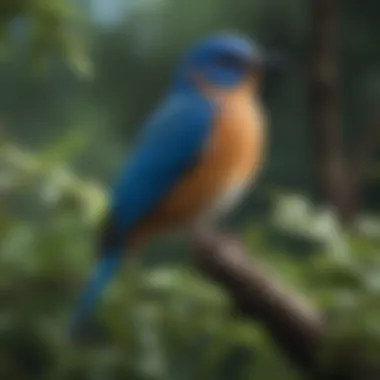
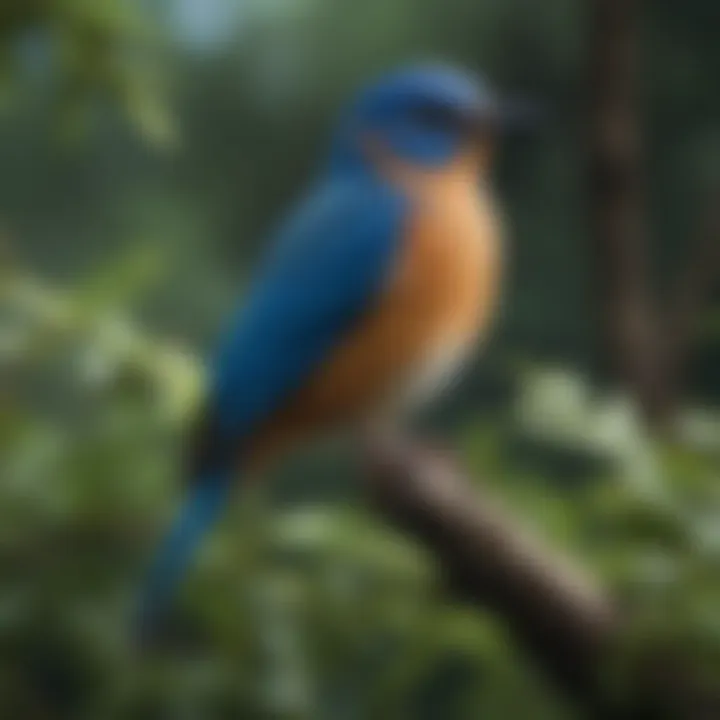
Nature Topic Overview
Blue birds, with their stunning plumage and enchanting songs, capture the hearts of many across the globe. They belong to various families and species, each showcasing unique traits and behaviors. Typically found in diverse habitats—ranging from lush forests to open fields—these birds play significant roles in their ecosystems. This article takes you on a journey to discover the magic hidden in their azure feathers, exploring their lives, the environments they call home, and the importance of preserving their habitats.
As we explore blue birds, we’ll learn about their behaviors, diets, and relationships with plants and other animals. We also uncover the threats they face due to habitat loss, climate change, and pollution. By understanding these beautiful creatures, we can take meaningful steps towards their conservation.
Fun Facts and Trivia
Did you know that blue birds are not just one species? Here are some fun tidbits that might surprise you:
- Blue Jay: This intelligent bird can mimic the call of a hawk. It’s like having an alarm system in your backyard!
- Eastern Bluebird: These birds are renowned for being symbols of happiness and renewal in many cultures.
- Mountain Bluebird: This bird prefers open spaces and is known for its vibrant, bright blue coat, making it a sight to behold.
By adding visuals and interactive elements, young readers can be driven to connect with these amazing species. Imagine spotting a blue jay perched on a branch, calling out to you!
Wildlife Explorations
The blue bird family encompasses a variety of species. Let’s dive into some of the most notable ones:
- Indigo Bunting: Males wear dazzling blue feathers during the breeding season, while females are more camouflaged with brown hues. They thrive in shrublands and are often found near fields.
- Western Bluebird: Equipped for life in open woodlands, they have beautiful blue and orange colors that make them easily identifiable.
In their habitats, blue birds interact with many plants and other creatures, creating a vibrant ecosystem. They often help with seed dispersal and pollination. Kids can engage more by taking quizzes or solving puzzles about blue birds and their habitats to see how well they know their feathered friends!
Environmental Awareness
Understanding blue birds emphasizes the significance of conservation. When their habitats are threatened, it impacts not just the birds but entire ecosystems. Here’s why we need to care:
- Biodiversity: Blue birds contribute to the diversity in ecosystems, which helps keep our environment healthy.
- Pollination and Seed Dispersal: Their roles in helping plants reproduce help sustain the cycle of life.
Children can play a part in protecting blue birds by practicing simple habits like:
- Planting native flowers that attract blue birds.
- Keeping the environment clean and litter-free.
- Encouraging families to support local conservation efforts.
DIY Nature Activities
Getting hands-on with nature allows kids to better appreciate it. Here are some fun activities they can try:
- Bird Feeder: Make a simple bird feeder using a milk jug or pine cone covered in peanut butter and bird seeds. Place it outside and watch who stops by!
- Blue Bird Crafts: Using colored paper, children can create their very own blue bird art.
Mixing these activities with outdoor explorations can foster a love for nature. Encourage kids to observe their surroundings and note any blue birds they spot!
Remember, every effort counts towards building a healthier planet. Let's protect the blue birds and all they represent!
Prelude to Blue Birds
Birds have a special magic. Among them, the blue birds stand out. Their vibrant color draws attention, sparking curiosity and admiration. When we talk about blue birds, we not only explore their beauty but also learn about their roles in nature. This section introduces young readers to the captivating world of these creatures, their significance, and the wonders they hold.
What Are Blue Birds?
Blue birds are a group of avian species known for their striking blue plumage. But they are more than just pretty faces. They belong to various families and inhabit different regions. Some familiar blue birds are the Eastern Bluebird, Blue Jay, and Indigo Bunting. Each of these species has its distinct personality and traits.
For instance, the Eastern Bluebird is often seen in gardens and fields, singing its sweet songs. The Blue Jay, on the other hand, is known for its chatter and intelligence. Learning about these birds gives us insights into the ecosystems they thrive in.
Looking deeper, blue birds exhibit a range of behaviors, from their feeding habits to their social interactions. Understanding what makes them unique can spark a fascination for wildlife in children and adults alike.
The Allure of Their Color
The color blue is rare in the avian world, often evoking feelings of calm and serenity. But how does a bird get its stunning hue? It’s not as simple as merely having blue feathers. The blue color comes from the microscopic structure of their feathers, which bends light in such a way that it reflects a bright blue. This makes them look even more striking against green leaves or a bright sky.
Furthermore, blue birds are often symbols in various cultures. They appear in folktales, art, and stories. For youngsters, learning about these birds' colors can motivate them to ponder nature’s wonders. Besides, the fascination with the color blue encourages them to observe their surroundings more keenly.
Some common phrases reflect this allure: "feeling blue" highlights the color's emotional connections, while talking about someone having a "blue mood" also represents its depth. Ultimately, this rich blend of biology, culture, and emotion showcases just how extraordinary blue birds truly are.
"In blue birds, nature paints its most vibrant creations, reminding us of the beauty that exists in unexpected places."
In the next sections, we will delve deeper into the different species of blue birds, their habitats, physical traits, and behaviors. Each aspect adds layers to our understanding, painting a comprehensive picture of these remarkable birds.
The Diversity of Blue Bird Species
When we talk about blue birds, it’s like opening a treasure chest filled with vibrant hues and captivating stories. Understanding the diversity of blue bird species brings us closer to appreciating these fascinating creatures and their unique roles in our ecosystems. They serve as indicators of environmental health and add color to our landscapes. By learning about different species, we can recognize the varied environments they thrive in and the vital contributions they make. This section focuses on common and rare blue bird species, showcasing their importance and inviting readers to explore more about them.
Common Species Overview
Eastern Bluebird
The Eastern Bluebird is a spectacular sight, known for its striking blue plumage and cheerful personality. Found throughout North America, this bird plays a key role in controlling insect populations, keeping gardens and fields healthy. One of the standout characteristics of the Eastern Bluebird is its vibrant blue back and rust-colored chest. This colorful appearance makes it a symbol of happiness for many. The unique feature of the Eastern Bluebird is its ability to thrive in open areas with scattered trees, which allows them to hunt insects easily and find suitable nesting sites.
- Advantages: They are known for their friendly nature, making them a beloved choice for birdwatchers. Their presence indicates a healthy ecosystem.
- Disadvantages: However, they face challenges from habitat loss and competition from invasive species.
Blue Jay
Blue Jays are known for their intelligence and adaptability. They are often seen darting about in forests and urban areas alike. The key characteristic of the Blue Jay is its striking blue and white feathers with a distinctive crest on its head. This bird stands out not just for its looks but also for its complex social behavior. Blue Jays are heavy seed eaters, especially acorns, playing a significant part in the ecosystem by helping to disperse oak trees.


- Advantages: They participate in seed dispersal, enhancing local flora. Their curious nature makes them a favorite among those who enjoy observing wildlife.
- Disadvantages: They can be aggressive towards other birds, thus sometimes discouraging less dominant species from nesting nearby.
Indigo Bunting
The Indigo Bunting is a dazzling bird, particularly impressive during the breeding season when males flaunt their stunning blue feathers. This brilliance is often described as a deep, rich blue, captivating all who spot it. The special aspect of the Indigo Bunting lies in its migratory behavior, traveling long distances between North America and Central America. Its unique feature includes a melodious song that can be heard during the day, often delivering a delightful serenade in open fields.
- Advantages: Their ability to thrive in various habitats means they contribute to the monitoring of environmental changes.
- Disadvantages: As a migrating species, Indigo Buntings face threats from habitat destruction along their migration routes.
Rare and Uncommon Species
Mountain Bluebird
The Mountain Bluebird, with its sky-blue feathers, brings a slice of the heavens down to earth. This species inhabits open regions in the western parts of North America. The key trait of the Mountain Bluebird is its striking coloration, often described as one of the most vivid among blue birds. Their willingness to forage in wide-open spaces makes them a fantastic sight against the backdrop of mountainous terrains.
- Advantages: They play an essential role in controlling insect populations in grasslands.
- Disadvantages: Their smaller population size makes them more vulnerable to environmental changes and loss of habitat.
Barn Swallow
The Barn Swallow is a charming bird with a long, forked tail and graceful flight patterns. Found predominantly near water sources, this species is a master at catching insects mid-air. One of the highlights of the Barn Swallow is its stunning blue-black upper body, contrasting with its warm, orange underparts. This swallow builds its nest in buildings and bridges, which connects it closely to human activity.
- Advantages: They consume vast amounts of insects, acting as natural pest control.
- Disadvantages: Their reliance on human structures for nesting can become a disadvantage if those structures are abandoned or demolished.
Scarlet Tanager
Though often considered a blue bird, the Scarlet Tanager brings a contrast of bright reds to the blue bird family. The male's vivid red feathers are heightened by subtle hints of blue. Found in North America's forests, the key highlight is its musical notes during the spring breeding season, which resonate through the woodlands. The Scarlet Tanager has a crucial role in the ecosystem by consuming insects and fruits, thus facilitating seed dispersal.
- Advantages: Their unique colors and songs add beauty and diversity to our forests.
- Disadvantages: They are increasingly affected by habitat degradation and climate change, making their future precarious.
Understanding the diversity of blue bird species enriches our knowledge about these creatures and their environments. Each species, common or rare, contributes to the intricate web of life that surrounds us.
Habitat and Range of Blue Birds
Understanding the habitat and range of blue birds is pivotal, as these factors significantly influence not only their behavior but also their survival in the wild. Different species of blue birds have adapted uniquely to various environments, allowing them to thrive under distinct conditions. By exploring their preferred habitats and geographic distribution, we can gain insights into the ecological roles these birds play and the challenges they face in an ever-changing world.
Preferred Habitats
Forests and Woodlands
Forests and woodlands are prime locations for many blue birds. They provide a wealth of resources such as food, nesting sites, and shelter. The dense foliage is like a buffet for bird species like the Eastern Bluebird and Blue Jay. They find an abundance of insects and fruits to feast upon in these areas.
These habitats often boast a variety of tree species, which not only contribute to food sources but also create perfect platforms for nesting. However, a drawback is that human encroachment often leads to habitat loss, posing a threat that needs urgent attention.
Grasslands and Fields
Grasslands and fields offer a different kind of ecosystem that blue birds also favor. Indigo Buntings, for example, are regularly spotted flitting through open fields filled with wildflowers. The sunny expanses provide ample opportunity to search for seeds and insects. Grasslands often experience less human disturbance than urban areas, making them a safe haven, yet they are not without risks. Agricultural practices threaten these habitats, leading to fragmentation and loss of breeding grounds.
Urban Areas
Interestingly, blue birds can be found in urban areas, too. Urban environments, despite the hustle and bustle, are adapting to support wildlife. Parks and gardens provide some necessary greenery for birds. Urban Blue Jays, known for their intelligence and adaptability, have found ways to thrive among buildings and streets. Yet, this comes with some disadvantages; noise and pollution pose challenges to their survival and reproductive success. Striking a balance between development and conservation is essential to ensure their presence in these vibrant areas.
Geographic Distribution
North America
North America hosts a rich variety of blue birds, making it a significant region for ornithologists and bird lovers alike. The Eastern Bluebird, for instance, thrives in open areas, often near human settlements and farmlands. As a result, North America serves as a critical habitat for this species, largely contributing to their population stability. Additionally, the migration patterns observed in these species paint a fascinating picture of their adaptation to seasonal changes. However, changing climate and habitat loss could upset this balance, demanding careful attention from conservationists.
South America
In South America, the landscape changes dramatically, yet blue birds like the Blue Dacnis thrive in tropical rainforests and open woodlands. Their vibrant plumage stands out against the lush greenery, drawing the eyes of bird watchers and scientists alike. The unique ecological niches found here enrich the overall diversity of avian life. However, deforestation translates to scarcity of habitats, threatening many species. Conservation efforts in these regions are crucial as they work toward preserving these beautiful birds.
Global Presence
Outside North and South America, blue birds can be seen stretching across various continents. Each region has its own unique representatives, exhibiting a fascinating array of adaptations. For instance, the Eurasian Blue Tit can be found throughout Europe and parts of Asia, navigating through gardens and parks. Their global presence emphasizes the interconnectedness of ecosystems and the importance of conservation efforts on a worldwide scale. However, differing regional challenges can create disparities in their survival, highlighting the need for international cooperation in wildlife preservation.
Physical Characteristics of Blue Birds
When studying blue birds, it's essential to understand their physical characteristics. These aspects not only add to their charm but also provide insights into their habits, habitats, and even their survival strategies. By examining the feather structure, colors, size, and shape variations, we can gain a richer appreciation of these delightful creatures.
Feather Structures and Colors
The feathers of blue birds are nothing short of remarkable. Their vibrant colors stem from a combination of pigmentation and structural coloration. Unlike many other birds that rely solely on pigment for color, blue birds use a unique physical structure of their feathers to scatter light.
The main pigment found in blue birds' plumage is melanin, but it's not the melanin that gives them their blue hue. Instead, it is the microscopic structure of the feathers that refracts light. For instance, the Blue Jay showcases how light interacts with the structure of its feathers, displaying stunning shades of blue that change depending on the angle of light.
When observing these birds, you might notice their feathers shimmering in the sunlight. This effect is not just a visual delight; it plays a critical role in attracting mates and communicating within species. The brilliant colors can signal health and vitality, essential factors in reproductive success.
Size and Shape Variations
Every blue bird species has its distinctive size and shape, which can impact their behavior and lifestyle. For example:
- The Eastern Bluebird is generally smaller and has a more rounded shape compared to others. This compactness allows it to dart quickly between perches while hunting for insects.
- The Indigo Bunting is slightly larger, with longer wings that enable it to migrate long distances swiftly. Their shape aids their ability to navigate diverse terrains.
These size and shape differences contribute to each species’ unique adaptations. Some can thrive in dense forests, while others prefer open fields or urban landscapes.
Understanding these physical traits illustrates how blue birds have evolved to suit their environments. Their shapes help in flight patterns, and their sizes may determine their predation strategies.
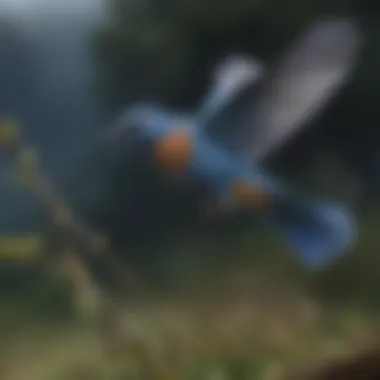
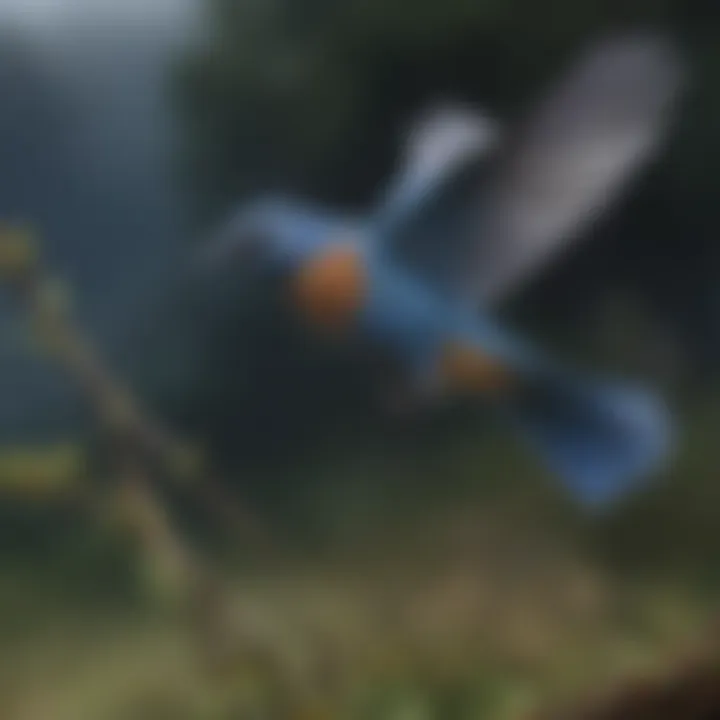
"The physical features of blue birds are more than mere ornamentation; they are vital tools for survival and communication."
Each characteristic, from feather colors to body shapes, intertwines with the bird’s ecological role and behavioral patterns, emphasizing the complexity and beauty of these aviary wonders.
Behavioral Traits of Blue Birds
Understanding the behavioral traits of blue birds is essential when exploring their unique world. These behaviors not only contribute to their survival but also reflect their intricate relationships within ecosystems. By knowing how they feed, mate, and care for their young, we can better appreciate these captivating creatures and the roles they play in nature. Birds engage in a variety of behaviors that are often influenced by their environment, providing insights into their adaptability and resilience.
Feeding Habits
Feeding is one of the most critical behaviors in the life of blue birds. Depending on the species, they have two primary feeding habits that shape how they interact with their habitat.
Insectivorous Diet
The insectivorous diet of many blue birds, such as the Eastern Bluebird, is particularly fascinating. These birds feast primarily on insects, which can include beetles, grasshoppers, and caterpillars. Having a diet rich in protein from these critters supports their growth and reproductive success.
- Key Characteristic: The agility with which blue birds hunt insects is impressive. They often swoop down from branches or hover above their prey before making a precise catch.
- Benefit: This diet not only fosters strong health due to high protein but also helps control insect populations in their environments, making it an essential behavior.
- Unique Feature: Some blue birds are known to forage in specific areas of trees, searching in crevices or on the undersides of leaves. This behavior reveals their foraging intelligence.
- Advantage: The readiness to catch insects allows blue birds to thrive in diverse habitats.
- Disadvantage: Relying heavily on insects may make them vulnerable during seasons when these are scarce, which can be a risk during extreme weather events or climate shifts.
Seed and Berry Consumption
On the flip side, blue birds also enjoy a seed and berry diet. This behavior is common among the Indigo Bunting and Blue Jay species, especially in the colder months when insects are less available.
- Key Characteristic: They tend to favor various seeds and fruits, including sunflower seeds, berries, and even nuts, which can be found in their habitats.
- Benefit: This adaptability to seed and berry consumption broadens their diet, allowing sustained energy levels year-round.
- Unique Feature: Many blue birds are adept at cracking open tough seeds, which indicates their specialized physical abilities.
- Advantage: Eating seeds and berries during winter helps them survive colder seasons when other food sources are limited, ensuring they can still thrive.
- Disadvantage: One downside of this behavior is that these food sources can sometimes attract pests, leading to competition with other birds and wildlife.
Mating and Nesting Practices
The mating and nesting behaviors of blue birds are crucial for species continuation. The way they choose mates and build nests showcases their adaptability and care for their offspring.
Building Nests
Nest-building is a remarkable aspect of blue bird behavior. Many species are meticulous about where and how they build their nests, often opting for hidden spots in trees or shrubs.
- Key Characteristic: Blue Jays, for example, are known to construct nests with various materials, including twigs, grass, and even human-made items like bits of plastic, which they collect from their surroundings.
- Benefit: This behavior contributes to their reproductive success, as a well-constructed nest can protect eggs and chicks from predators and harsh weather.
- Unique Feature: Some blue birds exhibit an interesting habit of reusing nests from previous seasons, showcasing their understanding of environment and safety.
- Advantage: Nesting in safe locations minimizes risks and fosters a safer environment for their young.
- Disadvantage: However, building a nest can be time-consuming and energy-intensive, and if conditions are poor, nests can be abandoned or destroyed.
Care for Offspring
Lastly, the care for offspring plays a significant role in the overall success of blue birds. The nurturing behaviors observed in these birds can deepen our understanding of their development and survival.
- Key Characteristic: Most blue bird species take turns feeding their chicks. This collaborative parenting ensures that the young receive enough nourishment during their crucial early stages.
- Benefit: Such cooperative care system could enhance the chances of survival for the chicks, allowing them to grow stronger and off on their own sooner.
- Unique Feature: In some species, the parents teach their fledglings hunting and foraging skills, which is an indication of complex behavioral learning.
- Advantage: Strong parental care results in healthier chicks that are more likely to survive into adulthood, making this behavior pivotal for population stability.
- Disadvantage: However, this intense caregiving can place significant stress on the parents, particularly in harsh environmental conditions where food is scarce.
In summary, the behavioral traits of blue birds not only fascinate observers but also highlight their crucial roles within ecosystems. Understanding how they feed, mate, and nurture their young provides a richer context for promoting conservation efforts targeting these remarkable species.
The Ecological Importance of Blue Birds
Blue birds are not just a delight for the eyes; they play vital roles in our ecosystems. The interplay between blue birds and their surroundings is quite fascinating. Each species contributes uniquely to the environment, helping various processes sustain life.
Role in Ecosystems
Blue birds hold significant positions in their ecological niches. Two key roles they fulfill are those of pollinators and seed dispersers. These functions directly impact plant life, agricultural health, and overall biodiversity.
Pollinators
Pollination is a critical aspect of many ecosystems. When blue birds flit from flower to flower, they unintentionally gather and transfer pollen. This process fosters plant reproduction, ensuring many species flourish. A key characteristic of blue birds as pollinators is their attraction to bright, colorful flowers, mirroring their vibrant feathers. This instinct leads them to abundant nectar sources, which are essential for their diet. Moreover, their beaks are well-suited for reaching the nectar, making them effective pollinators for certain plants.
However, the role of blue birds in pollination is not without challenge. As garden and urban environments expand, some blue bird populations struggle to find suitable flowers. This can impact the plants they help pollinate, demonstrating how interconnected their roles are within ecosystems. In the context of this article, it’s crucial to appreciate the unique contribution blue birds make as they support the growth of flora, which, in turn, benefits diverse wildlife.
Seed Dispersers
Just as they play with pollen, blue birds also engage in seed dispersal. After consuming berries and fruits, the seeds pass through their digestive systems and are deposited through their droppings. This method enables seeds to grow many miles from the parent plant, helping to spread plant species across vast areas. A significant advantage of blue birds acting as seed dispersers is their movement across varied terrains, enhancing genetic diversity among plants.
The unique feature here is that many seeds can only germinate after passing through an animal's gut. This allows blue birds to assist in the reproduction of plants that might face difficulties otherwise. On the flip side, habitat loss and fragmentation can hinder their ability to find enough food, leading to declines in both bird and plant populations. Thus, understanding the link between seed dispersers and overall plant survival draws attention to why blue birds should be cared for and protected.
Indicator Species
And let’s not overlook how blue birds serve as indicator species. Their presence— or absence— can signal the health of an ecosystem. Some blue birds are sensitive to environmental changes, such as shifts in climate or pollution levels. For example, a drop in blue bird numbers may hint at larger ecological troubles brewing nearby, serving as a rallying point for conservation efforts. This dependency makes them invaluable indicators of when and where action is needed to preserve our natural resources.
As we continue to learn about blue birds and their roles, we find ourselves understanding the intricate dance of life that weaves all creatures together. Protecting these vibrant inhabitants ultimately means safeguarding the lush web of biodiversity they help sustain.
Conservation Status of Blue Birds
The conservation status of blue birds is a vital topic, shedding light on the struggles and victories of these mesmerizing creatures. Understanding their environmental challenges not only raises awareness but also fosters a sense of responsibility in present and future generations. When we talk about the conservation of blue birds, it’s like holding a magnifying glass over the precise interactions within ecosystems and the ripple effects human activities create.
Threats to Blue Bird Populations
Blue birds face several threats that can ultimately lead to dwindling populations if left unchecked. The main culprits are habitat loss, climate change, and pollution.
Habitat Loss
Habitat loss is a significant problem for blue birds. This occurs when their natural environments are destroyed or altered, often due to urban development and agriculture. With the encroachment of cities and farms, blue birds lose their homes and food sources. Such loss disrupts their nesting habits and feeding routines, posing a serious risk to their survival.
A key characteristic of habitat loss is its often gradual nature, making it easy to overlook in the grand scheme of conservation. However, this stealthy nature only enhances its danger. As natural spaces vanish, blue birds find themselves increasingly isolated in smaller patches of habitat. This can lead to reduced genetic diversity, making them more susceptible to diseases.
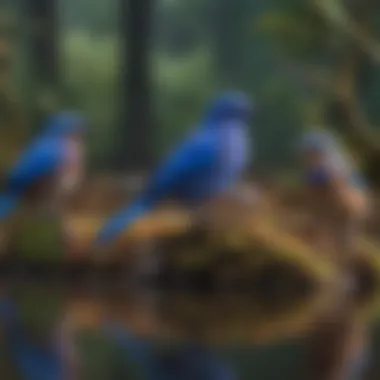
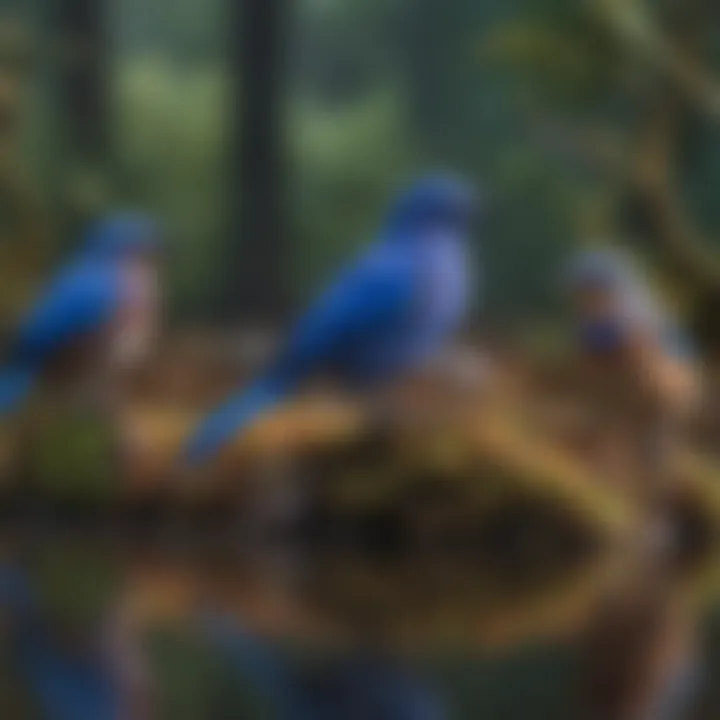
Climate Change
Climate change is another pressing issue that can’t be ignored. Changes in temperature and weather patterns affect food availability, breeding grounds, and migration routes for blue birds. For example, if warmer winters cause insects to hatch earlier, blue birds might return to their nesting grounds too late. This mismatch can affect their ability to feed their young, possibly leading to decreased survival rates.
One notable aspect of climate change is its pervasive effect across the globe. As temperatures rise, different regions may no longer be suitable for certain species. Blue birds could find themselves having to move to new territories, which may not always offer the same comforting conditions they once enjoyed.
Pollution
Pollution—specifically, chemical pollutants in their environments—poses a serious threat to blue birds. Pesticides and pollutants can invade their food chain, ultimately affecting their health and reproductive success. Studies have shown that chemical exposure can lead to reduced breeding success and even direct mortality.
The key characteristic of pollution is its stubborn persistence. Unlike many environmental issues, which can often be reversed through conservation efforts, pollution priorities often require shifts in policy and community behavior, making it a complex issue to tackle.
Conservation Efforts
Amidst these challenges, several conservation efforts work tirelessly to safeguard blue birds and their habitats. Protective legislation, community initiatives, and restoration projects play significant roles in enhancing their survival.
Protective Legislation
Protective legislation encompasses laws designed to preserve natural habitats and regulate threats to blue birds. This legislation can help designate critical habitats as protected areas, limiting activities that harm blue bird populations, such as deforestation or industrial development.
A vital aspect of protective legislation is its capacity to unite governing bodies with conservation organizations, pooling resources for maximum impact. This collaboration can lead to better enforcement of existing laws while also pushing for stronger regulations where gaps exist. By providing these legal safeguards, such legislation creates stable environments where blue birds can thrive again.
Community Initiatives
Community initiatives have proven effective in raising awareness and mobilizing local populations. Programs that educate residents about blue birds and the necessity of preserving their habitats can inspire collective action, like bird monitoring programs or creating local reserves.
The key feature of community initiatives is their grass-roots involvement. When people come together to focus on conservation, they create a supportive network that encourages sustainable practices and personal connections to nature. This fosters a stronger commitment to protecting blue birds in the long run.
Restoration Projects
Restoration projects focus on rehabilitating degraded environments, returning them to states that can support blue bird populations. This includes replanting native vegetation, creating wetlands, or restoring natural waterways.
An important element of restoration projects is their holistic approach. By addressing various aspects of an ecosystem, these initiatives can improve the overall health of an environment, benefiting multiple species, not just blue birds. Moreover, these projects often involve volunteers, strengthening community ties and awareness while directly contributing to conservation efforts.
"The survival of blue birds is intertwined with our actions. To appreciate their beauty is one thing, but to protect it is a call to responsibility."
In summary, each threat to blue birds brings unique challenges that require thoughtful and dedicated responses. By acknowledging these challenges and supporting ongoing conservation efforts, we can hope to see blue birds thrive in our environments for generations to come.
Appreciating Blue Birds in Nature
Blue birds hold a unique place in the hearts of many due to their striking colors and charming behaviors. The appreciation of these birds goes beyond mere admiration; it fosters a deeper connection with nature. Learning about blue birds can enhance our understanding of ecosystems and the delicate balance that sustains life.
Engaging with blue birds encourages mindfulness and observation, which are valuable skills for everyone, especially for kids. It pushes young explorers to look closely and appreciate the beauty around them rather than gaze at screens all day. This natural learning experience can inspire them to become advocates for wildlife conservation in the future.
Birdwatching Tips for Kids
Choosing the Right Environment
Finding the right spot to observe blue birds is crucial. Blue birds thrive in certain settings, and knowing where to look makes all the difference. Popular places, like parks and gardens, often attract various species, inviting kids and families to explore.
When picking an environment, consider natural habitats filled with native plants and trees. This helps keep the local food chain intact and increases the chances of spotting a blue bird. Kids can learn about how these birds interact with their surroundings, like nesting and foraging.
A downside might be the competition with other birdwatchers. However, this offers an opportunity to learn from one another about different species and habitats.
Identifying Species
Recognizing different blue bird species can be a fun challenge. Each bird has its unique features, from color variations to distinctive songs. This identification process promotes curiosity and learning about their behaviors and habits, making it more engaging for children.
Kids should pay attention to key characteristics such as size, shape, and specific markings. For instance, the Eastern Bluebird has bright orange breasts that stand out vividly against its blue wings. This not only makes it easier to identify but also sparks questions about why these traits might be beneficial for survival.
On the flip side, misidentifying a bird can lead to confusion. That said, making mistakes is part of the learning process and adds to the joy of birdwatching.
Art and Literature Inspired by Blue Birds
Blue birds have long inspired artists and writers alike. From paintings to poetry, their vibrant colors and gentle songs touch the human spirit. Artists often portray them as symbols of freedom and serenity.
In literature, blue birds frequently appear in stories as a source of inspiration or comfort, reminding us of the beauty in nature. Some writers use blue birds to symbolize hope. Reading about these birds can encourage young minds to create their own stories, tying imagination with nature’s wonders.
Whether through sketches, crafts, or tales, involving children in creative activities based on blue birds instills a love for nature in a tactile way. Watching blue birds can lead to more stories, crafts, and, ultimately, a lifelong appreciation for the feathered wonders in our backyards.
Closure
Concluding our exploration into the realm of blue birds is crucial for grasping their significance in our ecosystems. It’s not merely about appreciating their beauty; rather, it's about understanding their roles and the various challenges they face. Each point we've covered illuminates a piece of the intricate puzzle that these birds represent in nature.
Recap of Key Points
As we wrap up, let's highlight the central themes we’ve discussed:
- Color and Beauty: Blue birds are not just visually stunning. Their vibrant colors often attract attention and serve various functions in their natural habitat.
- Species Diversity: From the familiar Eastern Bluebird to the rare Mountain Bluebird, each species contributes uniquely to the ecosystem.
- Habitats: Understanding where blue birds thrive—be it in dense forests or urban parks—is key to appreciating their adaptability.
- Behavior and Ecology: Their feeding habits and nesting behaviors underline their ecological roles, such as controlling insect populations and dispersing seeds.
- Conservation: Gaining awareness of the threats they face, such as habitat loss and climate change, is vital for their preservation.
In summary, by understanding blue birds, young readers become connected not just to these birds but to a broader environmental narrative.
Call for Action
Now, what can you do with this knowledge? Here are some actionable steps:
- Observe Nature: Take a stroll in your local park or garden and look for blue birds. Bring binoculars and a notebook to jot down your observations.
- Join a Community: Participate in local birdwatching groups. Websites like reddit.com or facebook.com often have groups dedicated to bird enthusiasts.
- Educate Others: Share what you’ve learned with friends and family. Teach them how to spot blue birds and discuss the importance of conservation.
- Get Involved: Volunteer for conservation projects aimed at protecting wildlife habitats. Working hands-on can deepen your understanding and commitment to the cause.
- Advocate for Change: Use your voice and platforms to raise awareness about the threats that blue birds and other wildlife face. Encourage others to consider the impact of climate change and habitat destruction.
By taking these steps, you not only contribute to protecting these fascinating creatures but also enhance your own appreciation of nature. Remember, every bit helps—whether you’re nurturing flowers that attract birds or simply spreading the word about their importance in our ecosystems. Let's preserve the beauty and wonder of blue birds for generations to come!







